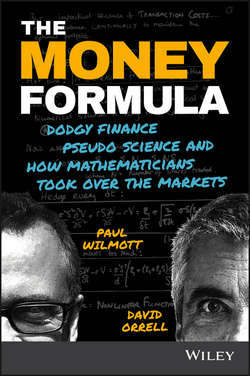The Money Formula

Реклама. ООО «ЛитРес», ИНН: 7719571260.
Оглавление
Wilmott Paul. The Money Formula
Acknowledgements
About the Authors
Introduction
CHAPTER 1. Early Models
CHAPTER 2. Going Random
CHAPTER 3. Risk Management
CHAPTER 4. Market Makers
CHAPTER 5. Deriving Derivatives
CHAPTER 6. What Quants Do
CHAPTER 7. The Rewrite
CHAPTER 8. No Laws, Only Toys
CHAPTER 9. How to Abuse the System
CHAPTER 10. Systemic Threat
Epilogue: Keep it Simple
Bibliography
WILEY END USER LICENSE AGREEMENT
Отрывок из книги
The authors would like to thank publisher Thomas Hyrkiel, project editor Jeremy Chia, production editor Samantha Hartley, and the rest of the Wiley team. Thanks also to Seth Ditchik, Ed Howker, Julia Kingsford, Robert Lecker, Beatriz Leon, Robert Matthews, Myles Thompson, and Andrea Wilmott.
David Orrell is an applied mathematician and writer. Founder of the scientific consultancy Systems Forecasting, his scientific work has encompassed diverse areas such as particle accelerator design, weather prediction, cancer biology, and economics. His books on subjects including prediction, economics, and science have been national bestsellers and have been translated into over ten languages. A revised and expanded version of his book Economyths: 10 11 Ways That Economics Gets it Wrong is also published this year. He lives in Toronto.
.....
After his losses in the South Sea debacle, Newton famously said: “I can calculate the movement of the stars, but not the madness of men.” While Newton may not have tried to calculate the markets, and preferred chemical alchemy to the financial kind, he probably did more to shape the world of mathematical finance than any other scientist. His law of gravity, coupled with his three laws of motion, provided an archetype for a successful mathematical model that would influence not just areas such as physics and chemistry, but also social sciences including economics, and serve as an inspiration for quants to the present day.
One person who appreciated the power of Newton's approach was Adam Smith. He is of course best known for his book The Wealth of Nations,10 which was the first to present economics as an objective, rational science, separate from areas such as ethics and political science. Some insight into his motivations is provided, however, by an earlier work on astronomy, written around 1758 but not published until after his death, in which his examination of “all the different systems of nature” culminates in a celebration of “The superior genius and sagacity of Sir Isaac Newton.” He was less impressed by John Law. As he wrote in The Wealth of Nations, “The idea of the possibility of multiplying paper to almost any extent was the real foundation of what is called the Mississippi scheme, the most extravagant project both of banking and stock-jobbing that, perhaps, the world ever saw.” (Smith would no doubt have been surprised to learn that we now organize our economies around Law's idea of a fiat currency, which was ahead of its time, rather than Newton's gold standard.)
.....